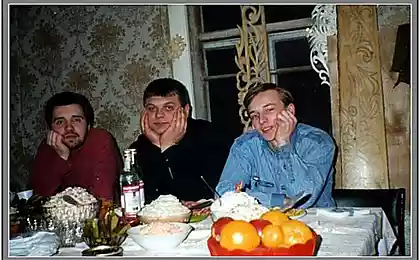897
The first tank, not a tractor!
History, as it were. The first tank, not a tractor!
45 photos and text
via armor.kiev.ua/Tanks

2 ...

3 ...

4 ...

5 ...

6 ...

7 ...

8 ...

9 ... Schneider
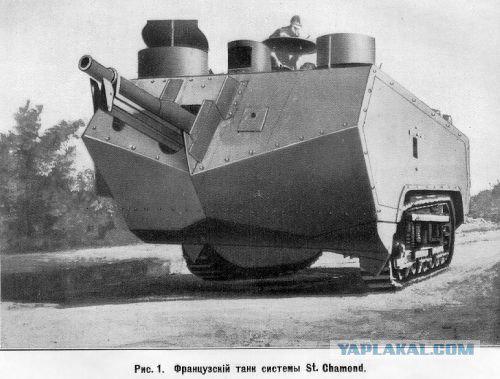
10 ...

11 ...

12 ...
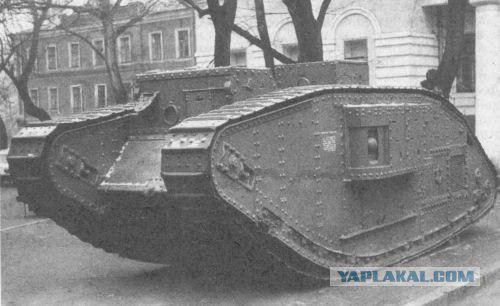
13 ...
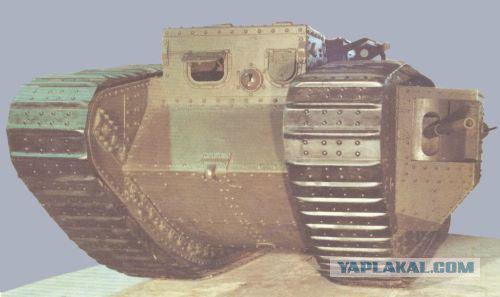
14 ...

15 ...

16 ...

17 ...

18 ...
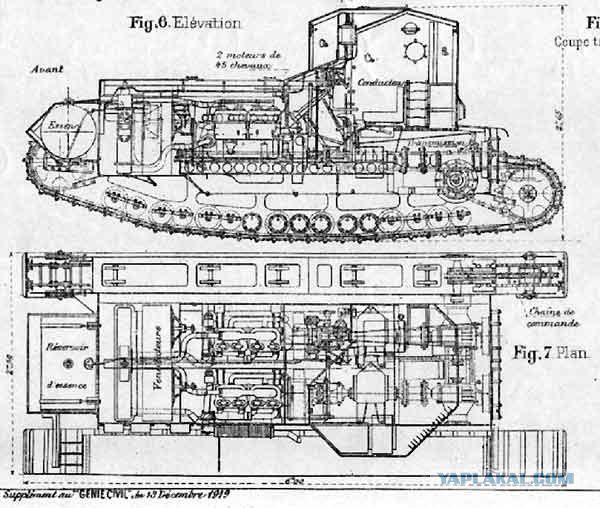
After the Battle of Cambrai, which was the high point for the tanks, even the most hardened skeptics became clear that in the future to carry out a successful offensive without the use of tanks is simply impossible. Without tanks advancing side for each kilometer conquered enemy positions was forced to pay tens of thousands of deaths and huge expenditure of ammunition. British tanks took to the field in the middle of the Great War. It is not that they have decided the outcome of the war, but their role is, in fact, turned out to be significant. The result of the use of tanks met all hopes placed in them.
Yet success can not hide the flaws of the new weapon. Heavy tanks had neither sufficient reserve or maneuverability. Among the British soldiers spread opinion about the need to complement the heavy tanks more mobile light. Previously, others realized it Colonel Fuller, who proposed the concept of a "cavalry" of the tank, which has a large reserve and high speed, even at the expense of cannon armament. In accordance with the theoretical assumptions Englishmen began to design a medium tank.
In principle, the firm W. Foster, his project was ready even before the order for such a car came from the military. The tank was made in December 1916, tested in February 1917 and in June of that year, the military issued an order for the first batch of 200 medium tanks.
In March 1918, the first production tanks, designated Mk.A., came off the assembly line of the plant. The new tank was created by William Tritton at the company W. Foster in Lincoln, considered a high-speed, and that developed twice the speed than the Mk-IV, has earned the nickname «Whippet» - «Greyhound" .Osobennostyu tank «Whippet» was the presence of two engines, instead of one, as in heavy tank. Placed engines "Taylor" power of 45 HP, was also unusually - in front of the case, near the fuel tanks. Each engine through its gearbox set in motion one of the tracks. A transmission and driving wheels at the rear of the housing. Rotation of the tank could be effected by one of three ways - either by reducing the number of revolutions of an engine, or by switching the transmission, or both at the same time in another way. One drawback of the design was that if a failure of one engine out, the tank could not continue to move.
In fact, it was not the only drawback of the tank. Despite the increase in speed to 14 km / h, the suspension remained tight (although by the time the French tanks had appeared with a soft suspension). Because of this, the speed of the tank Mk.A. the terrain was still low. The tank was very difficult to manage, and the driver was required considerable skill, and the view from the aft cabin that housed the crew and armament (4 guns) was unimportant. By rotating tower designers refused to simplify and reduce the cost of production of the tank, although a prototype "Whippet" - light tank Tritton had a rotating turret.
Mk.A. "Whippet" have been expensive and difficult to manufacture and use, but, nevertheless, superior to their heavy "colleagues". Tankers boasted that "Greyhounds" capable of self-propulsion to return from battle to their original position! Heavy Mk-I - Mk-IV due to frequent breakdowns and a small reserve of fuel is managed far vsegda.Mk.A. It began service March 26 1918. On that day, 12 tanks were sent to scout in Kolinko. And his first fight "Greyhounds" took under Villers-Bretonneux April 24, 1918. 7 tanks at a speed of 10 km / h were on the battlefield and fled about 1200 Germans, ready to attack. It killed 400 German soldiers. However, the price of success was great - 7 tanks returned 3, the other 4 were burned (knocked out one tank A7V № 525 "Siegfried"; three Mk.A. gunners destroyed).
Tanks «Whippet» took an active part in all the battles of the war, including at Amiens 8 August 1918, when 96 medium tanks Mk.A. the first time in the history of armored forces carried out what appeared to be an operational breakthrough. Tearing himself away from his infantry and cavalry followed, they had a spectacular raid on the German rear. As a result of concerted action by all arms of the British by the evening of that day managed to capture 16,000 prisoners and 400 guns, as well as move to 11 kilometers into the strong German defense. About how much Mk.A. «Whippet» could be a formidable weapon, can be judged by the actions of the tank with a rather strange nickname "The Music Box" Lieutenant Arnold at the Battle of Amiens. «Whippet», looking up from her is lying under heavy artillery fire cavalry alone made a daring raid on the German rear. Approximately 12 hours raid tank crew crushed battery scattered convoy of cars and wagons and destroyed more than 200 enemy soldiers. Only two hits, ignite gasoline spilled on the roof of the fortified spare cans, brought a tank failure. It should be noted that the canisters were secured in violation of the instructions (they are supposed to strengthen the back).
And yet, "cavalry" to become a tank «Whippet» failed. According to the personnel of the battalion "Whippets" interaction with the cavalry, as such, did not exist, and both kinds of weapons do not help each other, but rather the way. In the event of when the tanks had to turn to the cavalry, their rate was insufficient - they surpassed squads that went galloping. During the battle the cavalry could not keep up, it remained behind the infantry, tanks, and therefore «Whippet» had to fight on their own, helping the infantry, where it is convenient case. Entering the operating room would have been impossible without the support of infantry in armored personnel carriers and trucks, with no moving vehicles of communication and supply, without a clear interaction with the cavalry. All of this in 1918, it was impossible to achieve.
Trying to fix the design flaws Mk.A. the British in 1918, constructed two new versions of average tank - Mk.V. and Mk.S. Nor how successful they will not name. These machines in general repeated his predecessor. Tanks "grown up", but still retained the rigid suspension. Following the tradition of the British tank development, they have retained the form of heavy vehicles with tracks, covering the body. The layout of the tank changed. Deck and engine (now one -100 hp) reversed. Armament on both tanks housed in the wheelhouse in globular plants with limited angles of fire. Apart from the four guns in the cockpit, two machine guns at Mk.V. placed in the side sponsons, making the fighting compartment even closer. Mk.V. of overweight has turned to a medium tank. Because the engine power was not enough for the 18-tonner, its rate was even lower than that Mk.A. - Less than 10 km / h. On Mk.V. established product - equipment for creating smoke screens. The latest example of a medium tank, which the British set up before the end of the war, was Mk.D. Another designation of the tank - the Mk-I (not to be confused with a heavy!). It had a rotating turret, low case and was the first tank, "knew how to" swim. On the water tank kept at the expense of the volume of the body and moves at a speed of 5 km / h. Moving through the water carried by rewinding tracks with Tracians original oval shape, which is attached to the cable through the middle part ("serpentine track"). When the mass of 13, 5 m. Tank could develop due to the engine capacity of 240 liters. s., high enough at that time, the speed - up to 43 km / h. Mk.D. I had a crew of 4 tank and was armed with three guns. By the end of the war it produced 4 tanks.
The British command planned to release 6,000 medium tanks, but after the war greatly reduced the order, but only in the end, it was released 36 Mk.S. 200 and ordered 45 Mk.V. from the last 450 continued to serve in the British Army until 1925. Among procured by Japan in the early 1920s to test the tanks were a few ... A small number Mk.V Mk.V. operated by the Latvian army.
Trophy tanks Mk.A. used by the German army. Tanks Mk.A. and Mk.V. I had a chance to do some fighting in Russia during the Civil War in the ranks of the White Army and interventionists. They were distributed as follows. 3 tanks Mk.V., including two British and one Russian - № 1613 were part of the Northern Army. One of them was captured by the Red Army in 1920 in Arkhangelsk.
Army General Denikin had 2 detachment of tanks, 2nd and 4th, fully staffed Mk.A. 2nd squad included tanks "Tiger", "Stepnyak", "Sphinx" and "Crocodile" (later "Siberian"). 4th detachment consisted of tanks "General Wrangel", "Sadko", "General Skin" and "Uralets." Two Mk.A. took part in the storming of the Tsarina.
At the end of the Civil War "Whippets" I went to the Red Army. Under the name "Taylor" (according to the type of engines installed) 12 Mk.A. operated in the Soviet Union before the beginning of the 30s. 19 ...

20 ...
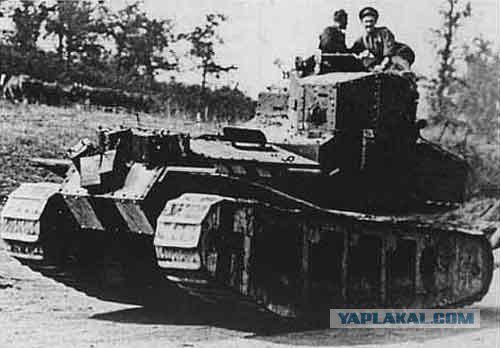
21 ...

22.

23 ...

Source:
45 photos and text
via armor.kiev.ua/Tanks

2 ...

3 ...

4 ...

5 ...

6 ...

7 ...

8 ...

9 ... Schneider

10 ...

11 ...

12 ...

13 ...

14 ...

15 ...

16 ...

17 ...

18 ...

After the Battle of Cambrai, which was the high point for the tanks, even the most hardened skeptics became clear that in the future to carry out a successful offensive without the use of tanks is simply impossible. Without tanks advancing side for each kilometer conquered enemy positions was forced to pay tens of thousands of deaths and huge expenditure of ammunition. British tanks took to the field in the middle of the Great War. It is not that they have decided the outcome of the war, but their role is, in fact, turned out to be significant. The result of the use of tanks met all hopes placed in them.
Yet success can not hide the flaws of the new weapon. Heavy tanks had neither sufficient reserve or maneuverability. Among the British soldiers spread opinion about the need to complement the heavy tanks more mobile light. Previously, others realized it Colonel Fuller, who proposed the concept of a "cavalry" of the tank, which has a large reserve and high speed, even at the expense of cannon armament. In accordance with the theoretical assumptions Englishmen began to design a medium tank.
In principle, the firm W. Foster, his project was ready even before the order for such a car came from the military. The tank was made in December 1916, tested in February 1917 and in June of that year, the military issued an order for the first batch of 200 medium tanks.
In March 1918, the first production tanks, designated Mk.A., came off the assembly line of the plant. The new tank was created by William Tritton at the company W. Foster in Lincoln, considered a high-speed, and that developed twice the speed than the Mk-IV, has earned the nickname «Whippet» - «Greyhound" .Osobennostyu tank «Whippet» was the presence of two engines, instead of one, as in heavy tank. Placed engines "Taylor" power of 45 HP, was also unusually - in front of the case, near the fuel tanks. Each engine through its gearbox set in motion one of the tracks. A transmission and driving wheels at the rear of the housing. Rotation of the tank could be effected by one of three ways - either by reducing the number of revolutions of an engine, or by switching the transmission, or both at the same time in another way. One drawback of the design was that if a failure of one engine out, the tank could not continue to move.
In fact, it was not the only drawback of the tank. Despite the increase in speed to 14 km / h, the suspension remained tight (although by the time the French tanks had appeared with a soft suspension). Because of this, the speed of the tank Mk.A. the terrain was still low. The tank was very difficult to manage, and the driver was required considerable skill, and the view from the aft cabin that housed the crew and armament (4 guns) was unimportant. By rotating tower designers refused to simplify and reduce the cost of production of the tank, although a prototype "Whippet" - light tank Tritton had a rotating turret.
Mk.A. "Whippet" have been expensive and difficult to manufacture and use, but, nevertheless, superior to their heavy "colleagues". Tankers boasted that "Greyhounds" capable of self-propulsion to return from battle to their original position! Heavy Mk-I - Mk-IV due to frequent breakdowns and a small reserve of fuel is managed far vsegda.Mk.A. It began service March 26 1918. On that day, 12 tanks were sent to scout in Kolinko. And his first fight "Greyhounds" took under Villers-Bretonneux April 24, 1918. 7 tanks at a speed of 10 km / h were on the battlefield and fled about 1200 Germans, ready to attack. It killed 400 German soldiers. However, the price of success was great - 7 tanks returned 3, the other 4 were burned (knocked out one tank A7V № 525 "Siegfried"; three Mk.A. gunners destroyed).
Tanks «Whippet» took an active part in all the battles of the war, including at Amiens 8 August 1918, when 96 medium tanks Mk.A. the first time in the history of armored forces carried out what appeared to be an operational breakthrough. Tearing himself away from his infantry and cavalry followed, they had a spectacular raid on the German rear. As a result of concerted action by all arms of the British by the evening of that day managed to capture 16,000 prisoners and 400 guns, as well as move to 11 kilometers into the strong German defense. About how much Mk.A. «Whippet» could be a formidable weapon, can be judged by the actions of the tank with a rather strange nickname "The Music Box" Lieutenant Arnold at the Battle of Amiens. «Whippet», looking up from her is lying under heavy artillery fire cavalry alone made a daring raid on the German rear. Approximately 12 hours raid tank crew crushed battery scattered convoy of cars and wagons and destroyed more than 200 enemy soldiers. Only two hits, ignite gasoline spilled on the roof of the fortified spare cans, brought a tank failure. It should be noted that the canisters were secured in violation of the instructions (they are supposed to strengthen the back).
And yet, "cavalry" to become a tank «Whippet» failed. According to the personnel of the battalion "Whippets" interaction with the cavalry, as such, did not exist, and both kinds of weapons do not help each other, but rather the way. In the event of when the tanks had to turn to the cavalry, their rate was insufficient - they surpassed squads that went galloping. During the battle the cavalry could not keep up, it remained behind the infantry, tanks, and therefore «Whippet» had to fight on their own, helping the infantry, where it is convenient case. Entering the operating room would have been impossible without the support of infantry in armored personnel carriers and trucks, with no moving vehicles of communication and supply, without a clear interaction with the cavalry. All of this in 1918, it was impossible to achieve.
Trying to fix the design flaws Mk.A. the British in 1918, constructed two new versions of average tank - Mk.V. and Mk.S. Nor how successful they will not name. These machines in general repeated his predecessor. Tanks "grown up", but still retained the rigid suspension. Following the tradition of the British tank development, they have retained the form of heavy vehicles with tracks, covering the body. The layout of the tank changed. Deck and engine (now one -100 hp) reversed. Armament on both tanks housed in the wheelhouse in globular plants with limited angles of fire. Apart from the four guns in the cockpit, two machine guns at Mk.V. placed in the side sponsons, making the fighting compartment even closer. Mk.V. of overweight has turned to a medium tank. Because the engine power was not enough for the 18-tonner, its rate was even lower than that Mk.A. - Less than 10 km / h. On Mk.V. established product - equipment for creating smoke screens. The latest example of a medium tank, which the British set up before the end of the war, was Mk.D. Another designation of the tank - the Mk-I (not to be confused with a heavy!). It had a rotating turret, low case and was the first tank, "knew how to" swim. On the water tank kept at the expense of the volume of the body and moves at a speed of 5 km / h. Moving through the water carried by rewinding tracks with Tracians original oval shape, which is attached to the cable through the middle part ("serpentine track"). When the mass of 13, 5 m. Tank could develop due to the engine capacity of 240 liters. s., high enough at that time, the speed - up to 43 km / h. Mk.D. I had a crew of 4 tank and was armed with three guns. By the end of the war it produced 4 tanks.
The British command planned to release 6,000 medium tanks, but after the war greatly reduced the order, but only in the end, it was released 36 Mk.S. 200 and ordered 45 Mk.V. from the last 450 continued to serve in the British Army until 1925. Among procured by Japan in the early 1920s to test the tanks were a few ... A small number Mk.V Mk.V. operated by the Latvian army.
Trophy tanks Mk.A. used by the German army. Tanks Mk.A. and Mk.V. I had a chance to do some fighting in Russia during the Civil War in the ranks of the White Army and interventionists. They were distributed as follows. 3 tanks Mk.V., including two British and one Russian - № 1613 were part of the Northern Army. One of them was captured by the Red Army in 1920 in Arkhangelsk.
Army General Denikin had 2 detachment of tanks, 2nd and 4th, fully staffed Mk.A. 2nd squad included tanks "Tiger", "Stepnyak", "Sphinx" and "Crocodile" (later "Siberian"). 4th detachment consisted of tanks "General Wrangel", "Sadko", "General Skin" and "Uralets." Two Mk.A. took part in the storming of the Tsarina.
At the end of the Civil War "Whippets" I went to the Red Army. Under the name "Taylor" (according to the type of engines installed) 12 Mk.A. operated in the Soviet Union before the beginning of the 30s. 19 ...

20 ...

21 ...

22.

23 ...

Source:











